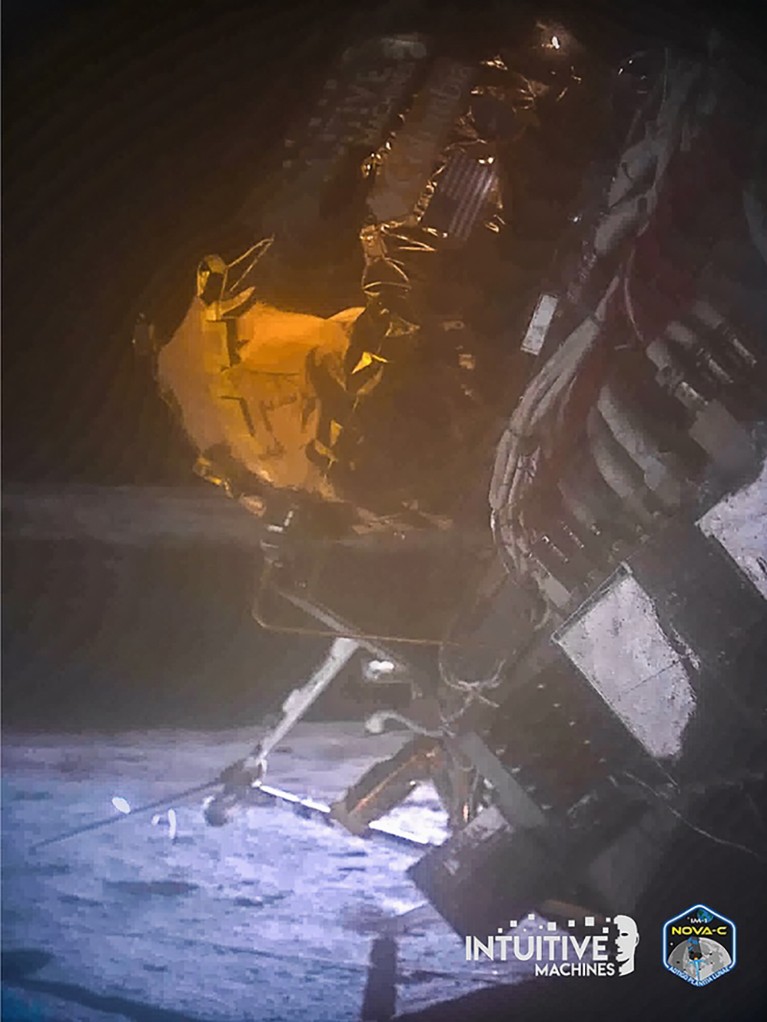Leaning on its side in the fading sunlight near the Moon’s south pole,
the first commercial spacecraft to soft-land on the Moon
is about to die. Mission controllers expect the Odysseus lander to lose power sometime on 28 February, six days after it touched down.
They will try to wake Odysseus again in about three weeks, when the Sun is overhead and shining light onto its solar panels. Chances are low that it will survive the freezing lunar night, although a Japanese lander
unexpectedly did so, waking up earlier this week
.

First private Moon lander touches down on lunar surface to make history
Space experts say that Odysseus, built by Intuitive Machines of Houston, Texas, counts as a success in the fledgling business of commercial lunar exploration. It is also the first US spacecraft to land on the Moon in more than half a century. All 12 of its payloads made it to the lunar surface, including six from NASA. Five of those NASA instruments have gathered scientific data, including measurements of radiofrequency interference leaking from Earth. The sixth, a retroreflector array that can be pinged to measure the distance between the lunar surface and other objects, will be tested in the coming months.
“What we’re seeing here is at least the beginnings of validating this concept, where NASA can trust commercial companies with this lunar landing service,” says Laura Forczyk, executive director of the space consulting firm Astralytical in Atlanta, Georgia. Odysseus
is the second spacecraft to launch
in NASA’s Commercial Lunar Payload Services (CLPS) programme; the first, from the Pittsburgh, Pennsylvania-based company Astrobotic,
did not make it to the lunar surface
because of a propellant leak. NASA paid Intuitive Machines US$118 million to help develop Odysseus.
Even though it was mostly successful, Odysseus encountered numerous challenges that underscore just how difficult it is to get to the Moon and operate on its surface. “When you’re trying things in a new way, with new technology, you’re going to expect bumps in the road,” Forczyk says.
A bumpy landing
Table of Contents
Odysseus launched on 15 February but ran into several problems, including an issue with its navigational star-tracking equipment that had to be fixed as it flew towards the Moon. As mission controllers prepared for its landing, they also realized that the spacecraft’s laser rangefinders, which help it to navigate down to the lunar surface, were not working. Engineers had to upload new software that would command Odysseus to use a separate laser instrument onboard, provided by NASA as a test, to help it land.

Private Moon launch a success! But will the craft land safely on the lunar surface?
But during that last-minute manoeuvre, mission controllers forgot to update part of an algorithm — so Odysseus touched down around 1.5 kilometres from its planned landing site and pitched onto its side. The landscape where it ended up was much rougher than anticipated, so “we hit harder and sort of skidded along the way”, says Steve Altemus, chief executive for Intuitive Machines. Odysseus broke at least one of its six legs, causing it to slowly tip over at a resting angle of about 30 degrees to the lunar surface.
That meant that some of its solar panels were not seeing as much sunlight as expected, and that its high-gain antenna could not be used to communicate with Earth. Mission controllers in Houston have been working overtime to get as much data from the lander as possible before it dies.
Mixed performance
As of 28 February, the company has released only one image of Odysseus on the lunar surface, taken by a narrow-field-of-view camera on the side of the lander. A student-built camera named EagleCam, which was supposed to eject off the lander and photograph its descent, was switched off because of the problems with the rangefinders.

Odysseus took this image of itself lying tilted on the Moon’s surface with a camera on the side of the lander.
Credit: Intuitive Machines/NASA CLPS
The problems during landing also meant that one of NASA’s main payloads, a set of four cameras meant to measure how rocket exhaust interacts with the lunar surface, also did not gather observations during landing. They were switched on during the last days of the lander, however. A separate, non-NASA astronomical imaging system reported collecting pictures of the lunar landscape and of Odysseus itself, but those photos won’t be released until 29 February.
Other instruments in the NASA collection were more successful, including the radioantennas that measured radiofrequency interference from Earth.
Odysseus’s mixed performance has sharpened attention on upcoming CLPS launches. Future NASA payloads include valuable instruments such as an ice drill and a rover that need to land successfully — and right-side-up — so that they can operate, says Carolyn van der Bogert, a planetary scientist at the University of Muenster in Germany. NASA wants the CLPS missions to help support its long-term goal of sending astronauts to the lunar south pole in the years ahead.
Intuitive Machines’ next launch is slated to carry that ice drill to the Moon sometime later this year. Astrobotic is supposed to fly the rover to the lunar surface, but its launch might be delayed until at least next year, while the company works to incorporate lessons from its failed mission last month.
